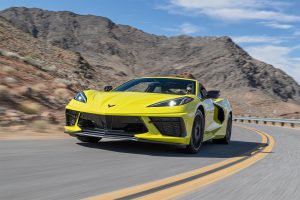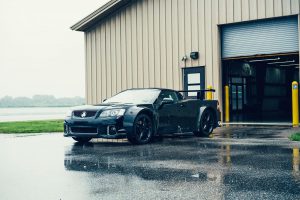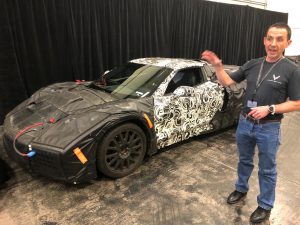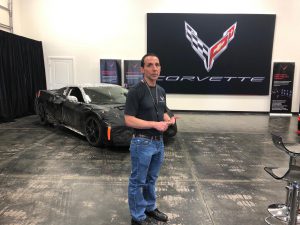With the launch of the new, eighth-generation Corvette, Chevrolet finally gets what it – and many fans – have long wanted: a mid-engine design that can truly compete with some of the world’s best sports cars.
It’s been a long time coming. Zora Arkus-Duntov, Corvette’s first chief engineer, began tinkering with the concept way back in 1960 with the CERV I concept vehicle. He described it as “a design without limit” and an “admirable tool,” contending that it showed GM “what to put in Corvette.”
Throughout the years, Arkus-Duntov and his successors would continue to tinker with the mid-engine concept, launching additional prototypes like CERV II and CERV III. But it would take until the middle of this past decade before senior management at General Motors finally gave the idea the go, according to Mike Petrucci, who served as lead development engineer on the 2020 Chevrolet Corvette, or C8.
(Review: 2020 “C8” Corvette is everything we hoped for.)

Original Corvette Chief Engineer Zora Arkus-Duntov helped develop these concepts: (l-r) CERV I, CERV III and CERV II.
If anything, it was still far from certain that the project would go into production when Petrucci and his team began putting together a rough – very rough – prototype in 2014. Dubbed “Blackjack,” it was an automotive Frankenstein, using bits and pieces borrowed not only from the then-new seventh-generation Corvette but also parts borrowed from GM’s operations in Australia. In fact, Blackjack still bears the Holden emblem on its hood.
“It was a convenient clown suit for us to hide our plan to develop a high-performance mid-engine sports car,” Petrucci said of the one-off project during a background briefing this past week.
With a significant amount of hand-tooled parts, Blackjack weighed about 7,000 pounds and used plenty of duct tape and bailing wire. “We had 24 engineers working to figure out how to stick all these parts together,” Petrucci laughed.
But the project did what he had hoped, convincing GM management to greenlight the effort and go for production.
“After we put Mark Reuss (then GM’s global product czar) in the car and he knew what we were doing, it was very clear there was high-level support.”
By 2016, the team began to pull together the first C8 “mule,” something a lot closer visually to what the eventual, 2020 Corvette would look like – though final design details were still being updated on the fly.
“This is not an attractive vehicle under the camouflage,” said Petrucci, pointing to one of the 11 cars his team pulled together – five of which were soon used for crash tests to see if the design could meet federal standards.
(First 2020 Corvette Stingray rolls off production line.)
The top of the instrument panel, for example, was a piece of cardboard held together by duct tape. The interior and doors were largely lifted from the C7 Corvette. But it gave the team the chance to start testing out key components that would eventually wind up in the production model, including the 6.2-liter LT2 V-8 and eight-speed Tremec dual-clutch transmission.
A year later, a third-generation prototype was ready for testing. By this point, there were still opportunities to make tweaks, but the more than 100 that eventually rolled out “were wholly design representative,” Petrucci said.
At this point, the focus was on vehicle integration, making sure everything not only fit together but that electronic systems could talk to one another, that steering and suspension settings were optimum and that the prototypes, as a whole, did what the engineering team wanted.
The other big challenge was to make sure the car they designed was buildable. “We had to confirm Bowling Green (the Kentucky site of the Corvette plant) could build the car accurately and repeatably,” said Petrucci.
At every step of the process, problems were discovered, changes required. It was only with the arrival of the 2017 prototypes that the team realized the Bowling Green plant would have serious trouble producing the original steering system. That required a fast shift to using a separate subframe that was easier to assemble while maintaining the necessary tolerances.
By the time the team was ready to move into production there were also some pleasant surprises. The C8 with the optional Z51 performance pack not only made a more-than-expected 495 horsepower but also managed 0-60 times of 2.9 seconds – only an eyeblink slower than the C7 ZR1 which made about 260 more horsepower.
As is always the case, “There is always a list of things (you want) but we ran out of time,” Petrucci told TheDetroitBureau.com. Though he declined to go into detail, colleagues suggested some of them might yet show up on future versions of the C8.
“Any time you do a new (vehicle) architecture you have to make sure there’s bandwidth for future products, even for things we hadn’t thought about,” said Petrucci.
(First Corvette C8 draws $3 million at Barrett-Jackson auction.)
For the moment, GM isn’t discussing what’s to come, it’s widely expected we’ll see next-generations of the Corvette Z06 and ZR1 models – and perhaps still other variants – make it to market over the next few years.




